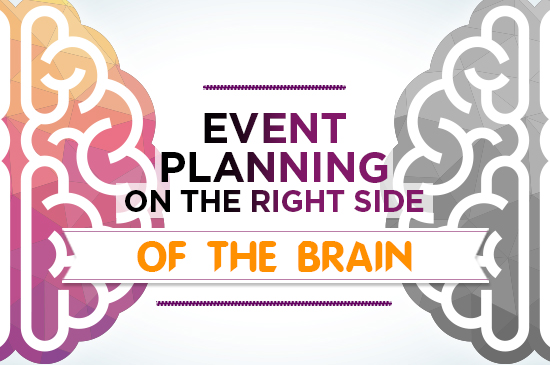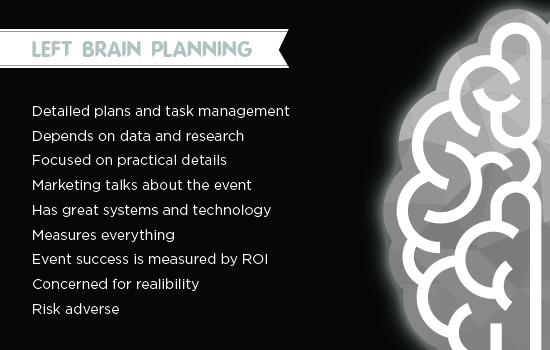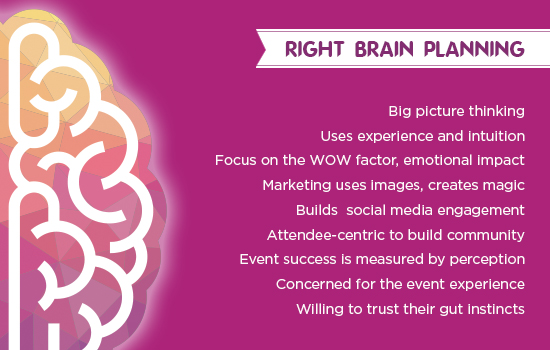Humans have extraordinary brains. There are more connections in an average human brain than there are atoms in the universe, which means that our biggest asset is the super-computer between our ears.

We process information using two very different but complementary processing styles, commonly referred to as the right brain and left brain. The left brain is characterized as logical, realistic and task focused. The right brain is known to be creative, emotional and intuitive.
The left and right sides work in a close partnership and meeting planners depend on this fine balance of creativity and logic. Yet, for many people one mode of thinking often dominates.

Some people are logical, practical, organized and methodical. They can’t help but see all the details and it’s difficult to settle on a plan until they know all the facts. These people are left-brain thinkers.
By contrast right brain thinkers are big picture thinkers, they enjoy the exploration and focus on the visual, emotional and social aspects of an event. They don’t need to know all the facts to make a decision.
In this article we look at how left versus right brained modalities affects the way we think about and plan events.
Left Brained Planning
When it comes to planning an event, there are lots of essential skills that the left side of the brain bring to the party.

The left brain is the organizer, it will gather together all the facts and create a roadmap for the event. The left brain is excellent with reports and RFPs, dealing with contracts and figuring out your return on investment. The left brain will make sure you have you analytics and reporting structure in place and will make decisions based on those reports.
Right Brained Planning
While the left brain plays a critical and necessary role in organization, left to its own devices it will create rather dull events. When we bring the right brain into the picture planning an event is no longer a series of milestones and tasks, it is an expression of our ingenuity, creativity and imagination.

The right brain is not only the more imaginative half, it is also critical for dealing with typical event planning challenges such as changes in schedule and resources, incomplete information, dealing with new groups and new people.
Someone who is highly biased towards left brain thinking will freeze in the face of breakdowns that take their carefully made plan off the rails.
The right brain is far superior when it comes to making decisions in chaotic and unpredictable circumstances. While the left brain depends upon orderly facts, the right brain can deal with incomplete and changing information. It is more flexible and uses gut instinct to reach rapid conclusions. The right brain can think on its feet, a critical skill when you are in the middle of an event.
The Emotional Brain
While we need the analysis and fact-finding powers of the left brain, when it comes to motivating our team, ourselves and our attendees we need right-brain thinking. We need to have an emotional connection to our events if we are going to really enjoy our work. When we are connected to WHY we are involved with an event, working late nights and pulling out all the stops is natural. Without the WHY all you have is hard work.
Finding a compelling WHY or purpose is right brain work. Although the left brain may be impatient to create milestones and action plans, if you take the time to create an overall vision for your event you will motivate and empower your team.
The left brain has goals and objectives. The right brain has passion and purpose. The right brain asks why this event is important, what will be the impact and how you will be of service to your attendees. The right brain is concerned for the emotional impact of the event and how people will feel, not whether you came in on budget. While budget, planning and goals are important what gives an event human impact lies in the emotional domain of the right brain.
How to Get the Best of Both Worlds
The right brain is not better than the left brain. The truth is we need both modes to run effective events. We need the left brain thinkers to keep us on track, set up our systems and analytics, review contracts and create the budget. We also need the flare and imagination of the right brain to make our events sizzle, to create memorable experiences, to navigate team dynamics and to make spot-decisions.
To get the best out of your left and right brain processing it can be useful to organize you time into blocks of creative and critical thinking. For example, at the early stages of planning and event you need lots of creativity and you don’t want to stifle the flow of ideas by getting bogged down in details. If left-brain details come up write them down and set them to one side. There will be plenty of time for details later.
On any given team you can expect to have a mix of left- and right-brain thinkers. Much upset can be avoided if you play to people’s strengths and are sensitive to these very different approaches to planning.
Conclusion
The characterization of left and right brain thinking that we have used here is an over-simplification. However, it can be useful to notice which mode predominates for you. If you are a left brainer, do you find yourself crushing creativity with your attention to detail? If you are a right brainer, what can do to bring more focus and organization to your planning?
Which people on your team are left-brain thinkers and which are right-brain thinkers? Sometimes mixing these modalities is like butting heads. Now that you understand the strengths of each approach, how can you get the best out of your team?
The best event planners are able to combine the imagination and flare of right brain with the focus and organization of the left-brain. Nurturing both modes of thinking and building teams that celebrate both styles can only lead to better events.





